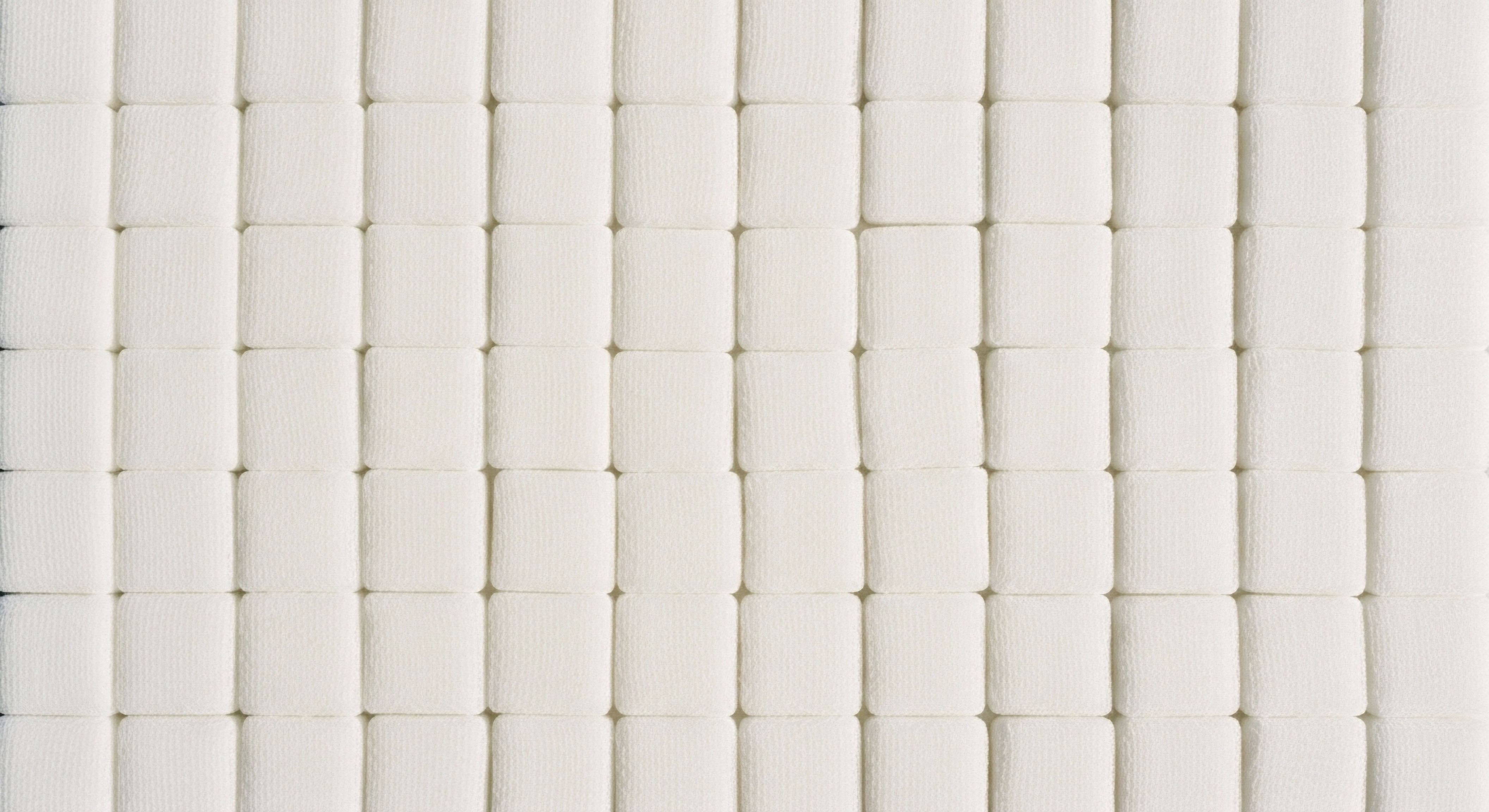

Fundamentals
Many individuals observe subtle shifts in their skin’s texture, resilience, and radiance over time, often attributing these changes to external factors or the natural progression of years. This lived experience of gradual alteration frequently sparks an intuitive understanding that something deeper influences our outward appearance.
Our skin, a remarkable and responsive organ, indeed mirrors the intricate symphony conducted by our internal biological systems. Understanding the specific hormonal protocols for skin vitality involves recognizing the profound connection between our endocrine system and the dermal landscape, translating complex biological mechanisms into actionable knowledge for reclaiming vibrant skin.
The endocrine system functions as a sophisticated internal messaging service, utilizing hormones as chemical signals to orchestrate a vast array of physiological processes. These potent biochemical molecules regulate everything from metabolism and mood to reproductive function and, significantly, the health and appearance of our skin.
A decline in the harmonious balance of these internal messengers frequently manifests as visible changes in skin quality, including diminished collagen production, reduced elasticity, and alterations in hydration. These hormonal influences shape the skin’s thickness, its capacity to retain moisture, and its overall youthful characteristics.
Hormonal balance serves as a profound determinant of skin health, directly influencing its structural integrity and visual characteristics.

How Do Endocrine Messengers Influence Dermal Architecture?
Our skin, comprising multiple layers, possesses a dynamic cellular environment where various hormone receptors reside. These receptors act as molecular locks, specifically designed to bind with circulating hormones, triggering a cascade of cellular responses. When hormones like estrogen, testosterone, and progesterone bind to their respective receptors within keratinocytes and fibroblasts, they initiate processes essential for maintaining skin’s structural integrity and youthful appearance.
These processes include stimulating the synthesis of crucial proteins such as collagen and elastin, alongside glycosaminoglycans like hyaluronic acid, which are vital for skin hydration and volume.
For instance, estrogen actively promotes skin thickness and suppleness by bolstering collagen content and enhancing moisture retention through increased hyaluronic acid levels. Conversely, declining estrogen levels, particularly during life transitions such as menopause, contribute to a reduction in collagen and elastin, leading to thinner, less elastic skin with increased dryness and fine lines.
Testosterone, present in both sexes, influences sebum production, which helps lubricate the skin. Optimal testosterone levels contribute to moisture retention and cellular turnover. Imbalances, whether insufficient or excessive, affect skin oiliness and overall health. Progesterone, a key female hormone, contributes to elastin production and maintains hydration, supporting a plump appearance.


Intermediate
Moving beyond the foundational understanding, a deeper exploration reveals the specific clinical protocols that can precisely target hormonal imbalances affecting skin vitality. These interventions aim to recalibrate the endocrine system, thereby addressing the root causes of dermal changes rather than merely ameliorating symptoms. Tailored hormonal optimization protocols offer a pathway to restore the skin’s innate resilience and luminosity, reflecting an internal state of well-being.

Targeting Hormonal Pathways for Skin Rejuvenation
Hormone replacement therapy (HRT) represents a well-established strategy for mitigating age-related hormonal declines, particularly in women experiencing perimenopause and menopause. Systemic HRT, involving the restoration of estrogen levels, can significantly enhance skin hydration, elasticity, and firmness. Studies indicate that oral estrogen therapy increases dermal thickness and collagen content, contributing to a reduction in wrinkles. Topical estrogen applications also demonstrate improvements in skin collagen and elastic fibers, though their effects remain localized to the application area.

Testosterone and Progesterone Optimization
Testosterone, while often associated with male physiology, plays a significant role in female skin health, influencing collagen production and cellular turnover. In men, appropriate testosterone replacement therapy (TRT) can improve skin moisture balance by optimizing sebum production. For women, low-dose testosterone protocols can support skin density and elasticity, contributing to a more robust dermal structure.
Progesterone supplementation also offers distinct advantages for skin health. It actively stimulates collagen synthesis, enhancing skin elasticity and reducing the appearance of fine lines. Progesterone also promotes skin hydration and thickness, leading to a smoother complexion. The synergistic action of progesterone with estrogen maintains hormonal balance, which is crucial for overall skin integrity.

Peptide Therapy and Dermal Regeneration
Peptides, short chains of amino acids, function as signaling molecules within the body, capable of stimulating cells to perform functions that diminish with age. Growth hormone-releasing peptides (GHRPs) and growth hormone-releasing hormones (GHRHs) are particularly relevant for skin vitality. These peptides stimulate the pituitary gland to naturally produce and release human growth hormone (HGH) in a pulsatile manner, mimicking the body’s physiological rhythms.
Growth hormone-releasing peptides stimulate natural HGH production, promoting skin elasticity and collagen synthesis.
This approach offers benefits such as improved skin elasticity, reduced wrinkles, and enhanced collagen production. Specific peptides frequently utilized in these protocols include:
- Sermorelin ∞ A GHRH analog that stimulates the pituitary gland to release HGH, leading to improved sleep, energy, and healthier skin.
- Ipamorelin ∞ A selective GHRP that increases growth hormone levels without significantly impacting cortisol, prolactin, or appetite, resulting in improved skin tone and reduced wrinkles.
- CJC-1295 ∞ Often combined with Ipamorelin, this GHRH analog provides a sustained release of growth hormone, contributing to enhanced body composition and skin benefits.
The table below summarizes the primary hormonal and peptide interventions relevant to skin vitality:
| Protocol Category | Primary Hormones/Peptides | Key Skin Benefits |
|---|---|---|
| Female Hormone Optimization | Estrogen, Progesterone | Increased collagen, enhanced elasticity, improved hydration, reduced wrinkles |
| Male Hormone Optimization | Testosterone | Balanced sebum, improved moisture retention, enhanced cellular turnover |
| Growth Hormone Secretagogues | Sermorelin, Ipamorelin, CJC-1295 | Stimulated collagen, improved skin tone, reduced wrinkles, enhanced tissue repair |


Academic
The pursuit of profound skin vitality necessitates an academic lens, scrutinizing the intricate molecular and cellular underpinnings of hormonal influence on dermal health. This deep exploration moves beyond superficial observations, delving into the precise biochemical dialogues that govern skin structure and function. Understanding these sophisticated mechanisms allows for the development of highly targeted and efficacious personalized wellness protocols.

Cellular and Molecular Mechanisms of Hormonal Action on Skin
The skin’s response to hormonal fluctuations stems from the ubiquitous presence of steroid hormone receptors within its various cellular compartments. Keratinocytes, the predominant cells of the epidermis, and dermal fibroblasts, responsible for extracellular matrix (ECM) production, possess specific receptors for estrogen, progesterone, and androgens. The binding of these steroid hormones to their intracellular receptors initiates a complex genomic and non-genomic signaling cascade, ultimately modulating gene expression related to skin integrity.
Estrogen, for example, exerts its effects primarily through estrogen receptors alpha (ERα) and beta (ERβ). Activation of ERs in fibroblasts upregulates the transcription of genes encoding type I and type III procollagen, tropoelastin, and fibrillin. This leads to increased synthesis of collagen and elastic fibers, the principal structural components of the dermis.
Moreover, estrogen enhances the production of hyaluronic acid and other glycosaminoglycans, which possess remarkable water-binding capacities, thereby contributing to dermal hydration and plumpness. Estrogen also influences the activity of matrix metalloproteinases (MMPs), enzymes responsible for collagen degradation, shifting the balance towards synthesis over breakdown.
Androgens, including testosterone, interact with androgen receptors (ARs) in sebaceous glands, stimulating sebum production. While excessive androgenic activity contributes to acne and oily skin, optimal levels are crucial for maintaining the skin’s lipid barrier and overall moisture balance. Testosterone also impacts fibroblast activity and collagen synthesis, contributing to dermal thickness and tensile strength.
Progesterone, acting through progesterone receptors (PRs), also influences ECM components. It has been shown to stimulate collagen production and enhance skin elasticity, often working synergistically with estrogen to maintain skin architecture.

Growth Hormone Secretagogues and Dermal Matrix Remodeling
The role of the somatotropic axis, particularly growth hormone (GH) and insulin-like growth factor 1 (IGF-1), in skin homeostasis and repair is well-documented. As we age, the pulsatile release of endogenous GH diminishes, impacting tissue regeneration. Growth hormone secretagogues (GHS), such as Sermorelin, Ipamorelin, and CJC-1295, represent a sophisticated pharmacological approach to restore physiological GH secretion.
Peptide-mediated growth hormone release supports cellular repair and collagen remodeling, fostering skin resilience.
These peptides stimulate specific receptors in the pituitary gland (GHRH receptors for Sermorelin/CJC-1295 and ghrelin receptors for Ipamorelin/GHRP-2/GHRP-6), prompting a natural, pulsatile release of GH. This endogenous stimulation avoids the supraphysiological, continuous elevation of GH associated with exogenous HGH administration, which can lead to adverse effects. The increased, yet physiological, GH levels subsequently elevate IGF-1, a potent anabolic factor.
The elevated GH and IGF-1 levels directly impact dermal fibroblasts, promoting their proliferation and enhancing their capacity to synthesize collagen types I and III, elastin, and hyaluronic acid. This leads to an increase in dermal thickness, improved skin elasticity, and a reduction in fine lines and wrinkles. Furthermore, GH and IGF-1 contribute to accelerated wound healing and enhanced skin barrier function, supporting overall dermal health.
The combined action of these hormonal and peptide protocols orchestrates a comprehensive dermal remodeling, addressing the multifactorial nature of skin aging at a cellular and molecular level. The precision of these interventions, guided by a deep understanding of endocrinology and cellular biology, allows for a truly personalized approach to skin vitality.
- Estrogen Receptor Modulation ∞ Estrogen binds to ERα and ERβ on fibroblasts, upregulating genes for collagen and elastin synthesis.
- Androgen Receptor Activation ∞ Testosterone binds to ARs in sebaceous glands, modulating sebum production and influencing dermal thickness.
- Progesterone Receptor Signaling ∞ Progesterone binds to PRs, stimulating collagen production and enhancing skin elasticity.
- Growth Hormone Secretagogue Receptor Interaction ∞ Peptides like Ipamorelin bind to ghrelin receptors, while Sermorelin/CJC-1295 bind to GHRH receptors, stimulating pulsatile GH release from the pituitary.
- IGF-1 Pathway Activation ∞ Elevated GH leads to increased hepatic IGF-1 production, which acts on fibroblasts to promote ECM synthesis and cellular repair.
The following table illustrates the specific cellular targets and molecular outcomes of key hormonal and peptide interventions:
| Hormone/Peptide | Cellular Target | Molecular Mechanism | Dermal Outcome |
|---|---|---|---|
| Estrogen | Fibroblasts, Keratinocytes | Upregulates collagen I/III, elastin, hyaluronic acid synthesis; downregulates MMPs | Increased thickness, elasticity, hydration, reduced wrinkles |
| Testosterone | Sebaceous Glands, Fibroblasts | Modulates sebum production; influences collagen synthesis | Balanced oil, improved moisture retention, enhanced density |
| Progesterone | Fibroblasts | Stimulates collagen synthesis; enhances elastin production | Improved elasticity, firmness, hydration |
| Sermorelin/CJC-1295 | Pituitary GHRH Receptors | Stimulates pulsatile GH release, leading to IGF-1 elevation | Enhanced collagen synthesis, improved skin tone, accelerated repair |
| Ipamorelin/GHRP-2 | Pituitary Ghrelin Receptors | Increases GH secretion without affecting cortisol, prolactin | Reduced wrinkles, improved skin elasticity, overall dermal regeneration |

References
- Calleja-Agius, J. & Brincat, M. P. (2012). Estrogens and aging skin. Climacteric, 15(4), 303-311.
- Varila, E. Rantala, I. Vihko, R. & Rantala, M. (1995). The effect of topical oestrogen on skin collagen in postmenopausal women. British Journal of Dermatology, 133(1), 93-97.
- Kopera, D. (2017). Impact of Testosterone on Hair and Skin. Journal of Clinical & Experimental Dermatology Research, 8(1), 1-4.
- Maheux, R. Naud, F. Rioux, M. St-Pierre, F. Lemay, A. & Guy, R. (1994). A randomized, double-blind, placebo-controlled study of the effect of 12 months of oral estrogen therapy on skin thickness in postmenopausal women. American Journal of Obstetrics and Gynecology, 170(5 Pt 1), 1434-1438.
- Klatz, R. & Goldman, R. (2003). Growth Hormone ∞ The Anti-Aging Hormone. Basic Health Publications, Inc.
- Baumann, L. (2007). Cosmeceuticals and Cosmetic Ingredients. McGraw-Hill Medical.
- Fitzpatrick, J. E. & Aeling, J. L. (2001). Estrogen and the skin ∞ An overview. Journal of the American Academy of Dermatology, 45(4), 570-574.
- Thornton, M. J. (2002). The biological actions of estrogens on skin. Experimental Dermatology, 11(6), 487-502.

Reflection
The journey toward understanding your skin’s vitality, illuminated by the profound influence of your endocrine system, represents a significant step in personal health optimization. This exploration of hormonal and peptide protocols is not merely an academic exercise; it forms the groundwork for a deeply personalized approach to well-being.
Recognizing the intricate biological dialogues within your body empowers you to move beyond superficial solutions, fostering a connection with your internal systems. Your unique biological blueprint dictates a tailored path, underscoring the importance of individualized guidance to translate this knowledge into tangible, sustained vitality and function.



